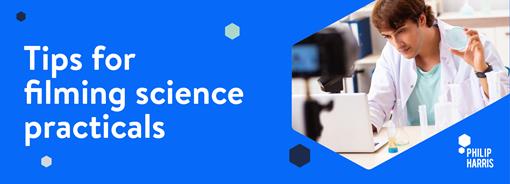Tips for filming science practicals

Chances are you are reading this because you want to know how to get the best out of filming a science practical. It is now easier than ever to record good quality videos of demonstrations, so with that in mind we asked our in-house video content expert Pete Heptonstall for his top tips on how to get the most out of filming a science experiment.
Why do we film science experiments?
There are lots of reasons to film a science experiment. The most obvious one is for demonstrating a science practical to be shown at a later date; either in the classroom, for remote learning or for sharing with the science team for personal development. Schools also use footage of the science department as part of their promotional activities to prospective pupils.
Filming is also useful to slow down and speed up practicals. You may wish to show something which is fast, such as combustion and slow it down for the pupils to see the process in detail. Conversely you can create time lapse footage of slower developments such as seed germination. You can find even more reasons for filming demonstrations in our using visualisers to demonstrate science blog.
You may of course fancy yourself as a social media star and share your passion for all things science, either with the rest of the science education community, or to use on your school’s channels for parents and guardians to see.
What should I use to film science practicals?
You can use a video recorder, a visualiser, digital microscope or even mobile phones are well equipped now to produce good quality footage.
Do I need to do anything before the day of recording?
First things first, check out the appropriate advice from CLEAPSS to set up the experiment and whether or not you need PPE such as eye protection or safety screens.
If you are using pupils in the video, you must obtain permission slips from parents too, otherwise your hard earned footage cannot be used.
Finally, double check the science you are about to present is correct – other specialist teachers will take great pleasure in proving your explanation is incorrect!
Pre-Recording:
- Try to work in a bright and well lit environment
- Try to avoid working in an area where there is a lot of background noise
- Set your recording device up so that you can see everything you need to show. If you need to record two angles to show ‘everything’ and then ‘detailed close ups’, set two recording devices up
- Landscape recording is always better for viewing than portrait
- Think about how much of your body is being videoed. Will it be best to see your face or is it better to zoom in to show what your hands are doing in more detail, for example in a dissection?
And things to avoid:
- Coloured liquids in glassware. As most chemicals are clear, it just looks fake
- Untidy backgrounds with equipment and chemicals ‘lying around’
- Identifiable photos of pupils and any work or displays with pupils’ full names on in the background
- Dressing up as a mad scientist. You want your video to have credibility and to inspire
During Recording:
- Leave a little break (not too long) at the start and end before you start talking
- Speak slightly slower and a little louder than you normally would to ensure your recording is clear
- Try to avoid blocking out what you are doing with your hands, arms or other equipment
- Always put items not in use to the sides to keep the shooting area focussed on what matters
- If something needs to be seen, pause and move your hands out of shot so that it can take “centre stage”
- If pupils are taking part in the filming, resist the temptation to crowd them all around the experiment in order to get them all in the frame
Post Recording:
And that’s a wrap! You may seek specialist help to edit the footage to ensure it suits your chosen output for web or social media, or there are apps you can use to do it yourself
- If you want to add text afterwards, ensure it stays on screen long enough to be read, is large enough to read, but doesn’t block what you are showing
- If you want to add background music chose something neutral that doesn’t distract the viewer from your voice and set it to be quieter than you would normally do
Get help setting up experiments and demonstrations for filming
The Philip Harris specialist team are here to help with any technical questions you have about setting up demonstrations and experiments ready for filming, or any other support you need. Call them on 0345 120 4521 or e-mail techsupport@philipharris.co.uk.
Check out our Twitter and Facebook for more tips for Science Technicians and Teachers








